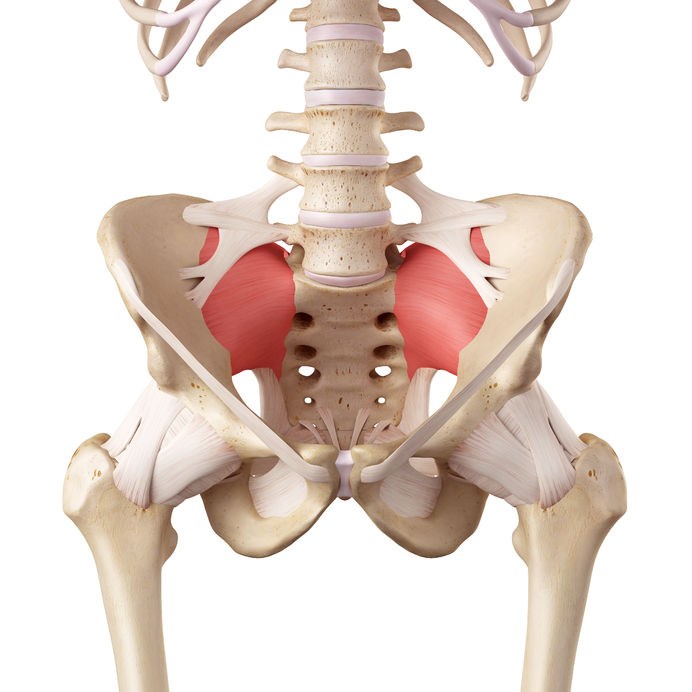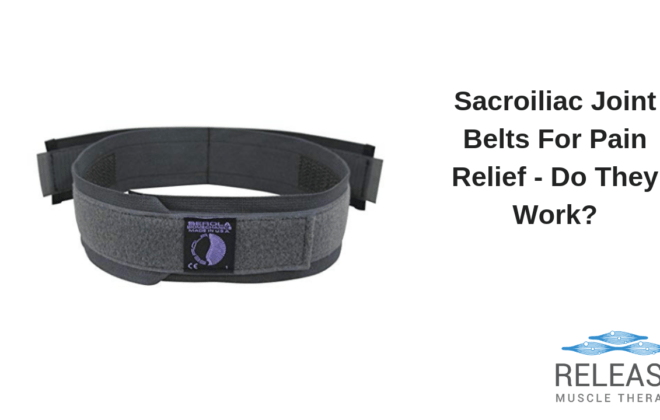5 SI Joint Pain Relief Stretches That Are Safe And Effective

SI joint pain is a common issue, and there is often very confusing information on these joints found online.
The SI joints themselves move very little, if at all in some individuals. Thus getting a sacroiliac joint stretch itself is not possible nor desired.
Stretching for SI pain is accomplished by targeting the surrounding muscles that serve to stabilize the lumbo-pelvic-hip region, and transmit forces effectively across these joints.
Note: If you’re dealing with SI Joint issues and need a specific step-by-step protocol, be sure to check out my SI Joint Solution program.
SI Joint Pain Relief Stretches To Try
The following stretches will target the specific muscle groups that can influence position of the lumbar spine and hips, and thus sacroiliac joint pain. The reduction of excess muscle tension can provide relief and improve a more even force transfer across the sacroiliac joints.
Kneeling Hip Flexor Stretch
The hip flexor muscles influence the SI joint primarily via their ability to anteriorly rotate the pelvic bone (innominate). This movement increases extension in the lumbar spine.
The iliopsoas muscle originates on all five lumbar vertebrae, and inserts on the inside of the upper thigh. This is by far the most mentioned muscle in hip flexor group, but its far from the only important one.
The other hip flexor muscles include the rectus femoris, sartorious, and tensor fascia lata. A classic quadriceps stretch would target the rectus femoris, but not adequately stretch the others.
As a group, they can be stretched with the Kneeling Hip Flexor Stretch.
Cross Knee Glute Stretch
The gluteal muscles have a strong influence on SI joint pain through the origin on the sacrum and insertion on the upper back of the thigh bone. They extend, abduct and rotate the leg outward.
No discussion about the glutes and pain is complete without mentioning the piriformis muscle. Much like the psoas, the piriformis is often the primary target for stretching when any pain exists in the hip or lower back exists, but its not clearly emphasized relative to the other more superficial gluteal muscles.
Stretching the glutes as a group can be easily accomplished with the Supine Cross Knee Glute Stretch.
Swiss Ball Quadratus Lumborum Stretch
The quadratus lumborum (QL) is freqently considered the “hip hike” muscle, and has a strong influence on the pelvis and lumbar spine in the frontal plane. In essence, elevating a hip will result in an added rotation to the pelvis.
This side bending + rotation can contribute to sacroiliac joint pain in some people. The QL is simple enough to release with a Swiss Ball Side Stretch.
Standing Adductor Stretch
The hip adductors have a close relationship with the quadratus lumborum. When one hip is hiked, the adductor muscles on that same side will be put in a shortened position. Shortness on both sides is often associated with increased anterior pelvic tilt beyond optimal amount.
Getting a hip adductor stretch is accomplished by opening the legs sufficiently with legs straight while adding a small posterior pelvic tilt to target the tight muscles.
The Standing Adductor Stretch is my go-to for this muscle group.
Supine Hamstring Stretch
The hamstring muscles are probably the most influential muscle groups when it comes to stabilization of the sacroiliac joints. This is partly due to their merging with the sacrotuberous ligament via the ischial tuberosity (sit bone).
They are frequently found shortened during assessment, but they can also commonly be found lengthened and weak. Either shortness + weakness or length + weakness can exist and contribute to SI joint pain.
Stretching isn’t usually a problem even if the hamstrings are found to have excessive range of motion, but it won’t likely be particularly helpful in that situation, as strengthening is the best option.
The Supine Hamstring Stretch is a simple option for emphasizing the hamstrings.
Tips To Make Stretching More Effective
Stretching Holding Time
The standard recommendation for stretching is to hold for 30 seconds x 2-3 repetitions. There isn’t anything magical about 30 seconds, but there should be enough time to relax into the stretch. Up to 60 seconds can be used if the stretch is at low-moderate intensity.
Frequency Of Stretching
The outcome of stretching isn’t to lengthen the muscle itself (this takes months and months of consistent and progressive stretching!), but instead to reduce neuromuscular tension.
Therefore, it is useful to apply stretching with a higher degree of frequency. Twice per day is the usual recommendation, but it can be done more frequently IF the intensity is kept low.
A good rule is to avoid muscles soreness as a result of stretching.
Integrate With Resistance Training
Stretching can result in good range of motion improvements over the short term, but the problem is getting those results to “stick”. One of the most effective ways to accomplish this is via full range of motion resistance training.
Strengthening muscles into their stretch position improves tolerance and continues the adaptation process.
Additional Considerations For SI Joint Muscle Stretching
Use Good Technique
Remember, the goal isn’t to force muscles to lengthen. The goal is to reduce excess muscle tension through relaxation and reduction of threatening input from the tissues.
There is no need to bounce or be excessively aggressive with stretching.
Start With Low Intensity To Test
To carry on from the previous point, whenever it comes to sacroiliac joint pain, its always important to consult with your healthcare provider when selecting the best stretches, but also to start slow and easy.
Low intensity to test is a smart way to begin. You can always increase the intensity of the stretch as tolerated.
Does Not Aggravate SI Joint Pain
Unless advised specifically by your healthcare provider, never stretch through pain. If you’re experiencing pain with any specific movement, reduce the range of motion, the intensity, or hold long the stretch is held. If that doesn’t help, stop the movement and talk with your health pro for further advice.
Conclusion
The above SI joint pain relief stretches can be a simple and low-threat way to alleviate si joint pain. They should always be modified to the individual’s needs and should be part of an overall approach to addressing sacroiliac joint pain.
Related Articles
5 Special Tests To Uncover SI Joint Dysfunction
How To Know If Your SI Joints Are Causing Your Pain
Sacroiliac Joint Belts – Do They Work?
How To Sit With SI Joint Pain?
Best Mattresses For SI Joint Pain
Yoga For SI Joint Pain – Here Are The Best Poses
Sam Visnic
Most Popular Posts
Categories
- Deep Gluteal Pain Syndrome (8)
- Deltoids (2)
- Foam Rolling (2)
- Glutes (9)
- Hamstrings (5)
- Hypnosis for Pain (3)
- Lats (2)
- Levator Scapulae (4)
- Lifestyle (8)
- Massage Therapy (39)
- Mobility (21)
- Movement and Exercise (19)
- Muscles (22)
- Nutrition (2)
- Obliques (1)
- Pain (25)
- Pectorals (3)
- Piriformis (3)
- Plantar Fasciitis (11)
- Psoas (11)
- Quadratus Lumborum (3)
- Quadriceps (2)
- Rhomboids (3)
- Sciatica (1)
- Serratus Anterior (1)
- SI Joint (14)
- Sternocleidomastoid (1)
- Stretching (18)
- Subscapularis (1)
- TMJ (2)
- Trapezius (1)
- Uncategorized (12)








